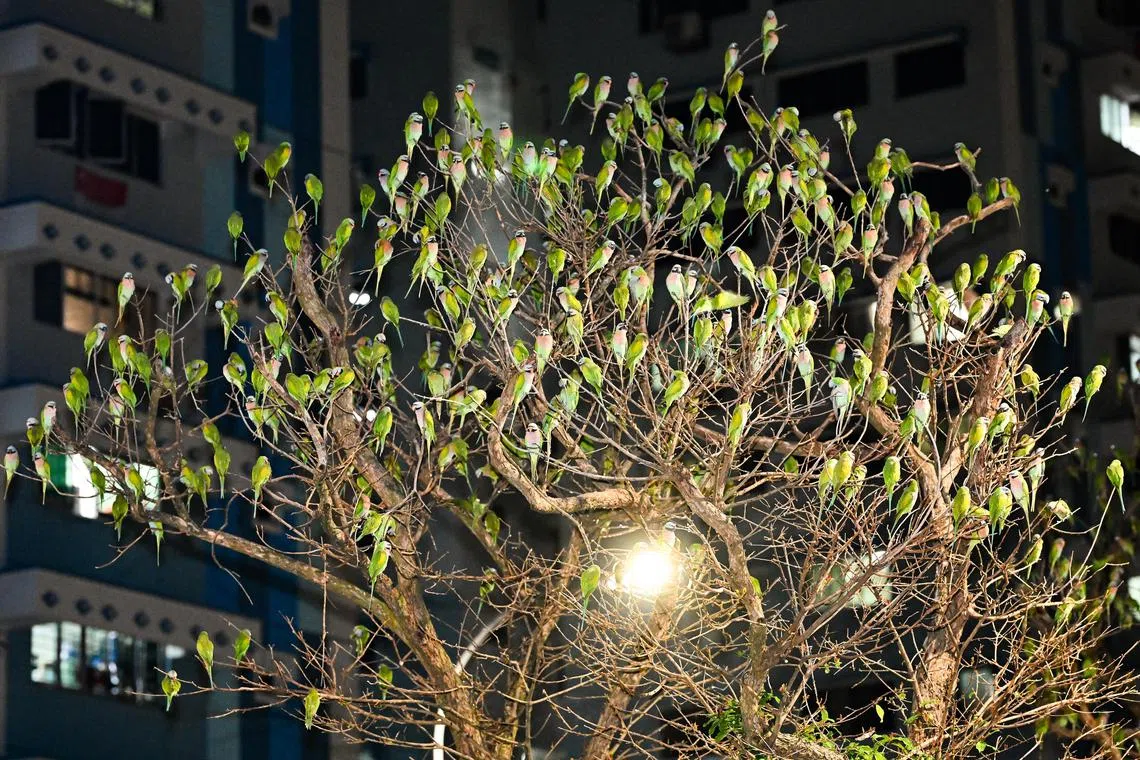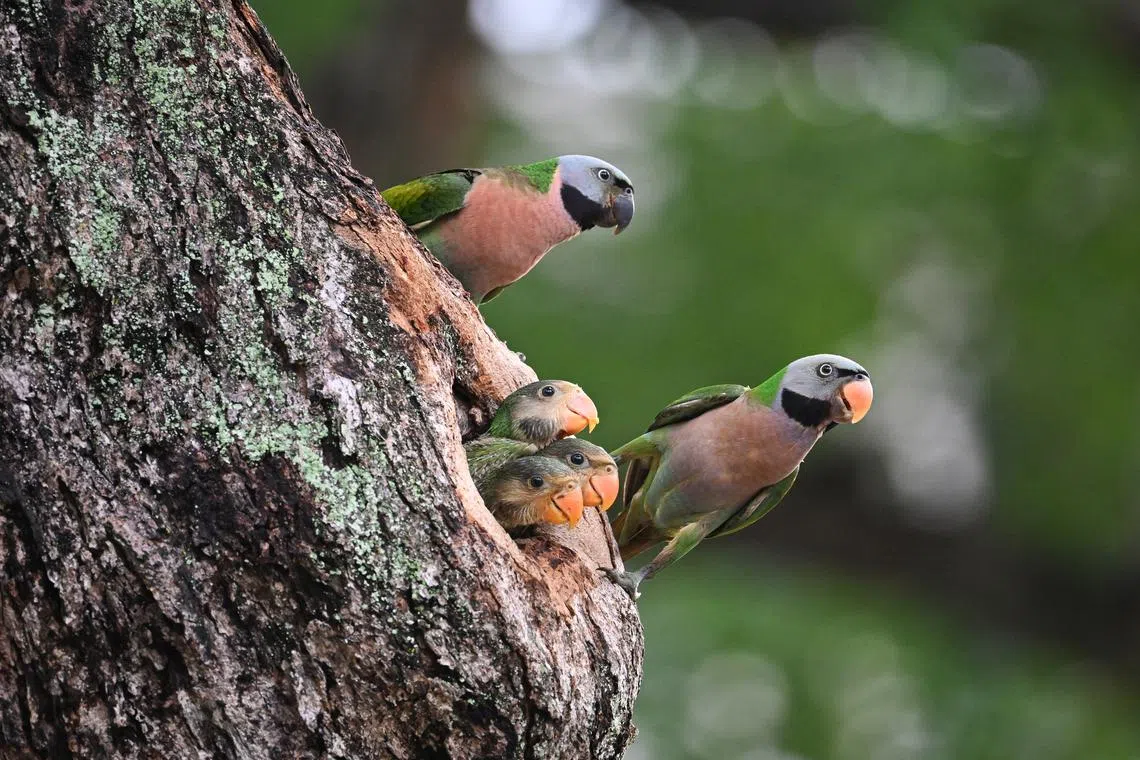Large flocks of parakeets a spectacle in Choa Chu Kang, but they may affect native species
Sign up now: Get ST's newsletters delivered to your inbox

A resident said the flocks of birds start taking flight at about 7am and return to the trees about 12 hours later in the evening.
ST PHOTO: LIM YAOHUI
Follow topic:
SINGAPORE – They could be mistaken as leaves on a tree at first glance, but a closer look reveals feathered creatures perched on the branches.
Recent sightings of a huge flock of red-breasted parakeets in Choa Chu Kang have renewed attention to the bird situation in the estate. There had been reports of such sightings in 2022 and 2023.
These parakeets have been spotted on the almost-bare tree branches between Block 415 Choa Chu Kang Avenue 4 and Block 352 Choa Chu Kang Central, with at least 250 of them perched on one tree.
Resident Lu Yixin said the flocks of birds start taking flight at about 7am and return to the trees about 12 hours later in the evening.
“They all fly off, group by group. It’s a very beautiful sight and feels very organised. They will return in the evening when it just begins to get dark.
“They follow the same routine every day, like clockwork,” said the 25-year-old architecture student.
“I often reach home after dark and when I alight at the bus stop and see or hear the birds, there’s this very nice feeling of returning home,” he added.

Red-breasted parakeets are native to north-east India and South-east Asian places like Java, Bali and Indochina.
ST PHOTO: LIM YAOHUI
Red-breasted parakeets are native to north-east India and South-east Asian places like Java, Bali and Indochina.
They were introduced here in the 1940s through the pet trade, and their population has become self-sustaining, with local breeding recorded. To date, they can be found in parks, gardens and scrubland across Singapore.
The birds may be attractive, but experts say they may disrupt the local ecosystem.
Mr Alan OwYong, committee member of the Nature Society Singapore’s (NSS) bird group, said the red-breasted parakeets compete for food and nest holes with native parakeets such as the long-tailed parakeets.
Large flocks of these birds also create imbalance in the natural avian biodiversity due to their “more aggressive” behaviour and “wasteful” feeding habits, he added.
The most directly impacted by this competition for the same resources would be the native long-tailed parakeet, which shares the same ecology as its red-breasted cousin, said Bird Society of Singapore’s vice-president Raghav Narayanswamy.
He added that more work will be needed to more precisely determine the effects of the red-breasted parakeets on the native long-tailed parakeets, as well as other species.
However, he added that the native long-tailed parakeets still do well in more wooded areas.
For example, considerably more of them have been observed in the Central Catchment Nature Reserve than the red-breasted parakeets.
This could be because the latter prefer more open habitats, and are hence sighted more often in areas like Housing Board estates and parkland, he said.
Dr Yong Ding Li, who coordinates NSS’ annual count of introduced and native parrots in urban areas, said the red-breasted parakeet population in Singapore is estimated to be from 8,000 to 12,000.
“The large number of red-breasted parakeets indicates that they have been reproducing successfully in Singapore,” said Mr Tan Gim Cheong, vice-chairman of NSS’ bird group.
He added that these parakeets may affect the breeding of other native species.
“The red-breasted parakeet will chase away other birds from the tree-holes that they have set their sights on for nesting, which in turn means that they may have denied native birds the use of the tree-holes for the period that they are raising their young,” said Mr Tan.

Red-breasted parakeets with their chicks at Jalan Bukit Merah on Oct 14, 2024.
ST PHOTO: LIM YAOHUI
On why the red-breasted parakeets may have chosen to roost in Choa Chu Kang, Ms Veronica Foo, who chairs the NSS’ bird group, said they choose to roost in certain places that offer protection from predators and weather.
“They prefer familiar and safe places that have high perches or dense foliage in trees. In the absence of these, they will fly to look for other suitable roosting sites,” she said.
In response to queries from The Straits Times, National Parks Board (NParks) group director for wildlife management How Choon Beng said that NParks is aware of the parakeet population established in Choa Chu Kang.
He added that the board takes a science- and community-based approach to manage the populations of non-native bird species, to minimise their impact on native biodiversity and habitats.
“As the area where the parakeets roost is also heavily interspersed with crows and mynahs, NParks and the Town Council employ a suite of bird management measures, including conducting nest surveys, nest removals, tree pruning and bird-trapping operations in the neighbourhood regularly,” he said.
“During such operations, we will release any native species and humanely put down birds of non-native species with established populations.”
There has not been any comprehensive study to track the population size of red-breasted parakeets in Singapore, Mr How said.
He added that parakeets are known to keep close to their flocks and not cause disturbances to pet birds kept in cages.
NSS’ Ms Foo stressed that pet owners should be responsible and not release non-native birds into the wild.
“They can populate quickly if the environment or habitat is suitable, outnumbering our native species.
“It is also cruel when non-native birds are released and they starve or get preyed on if they are unable to find food or safe roost,” she added.


